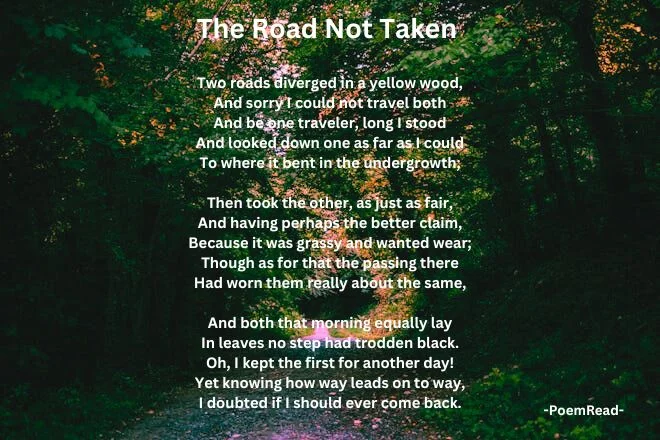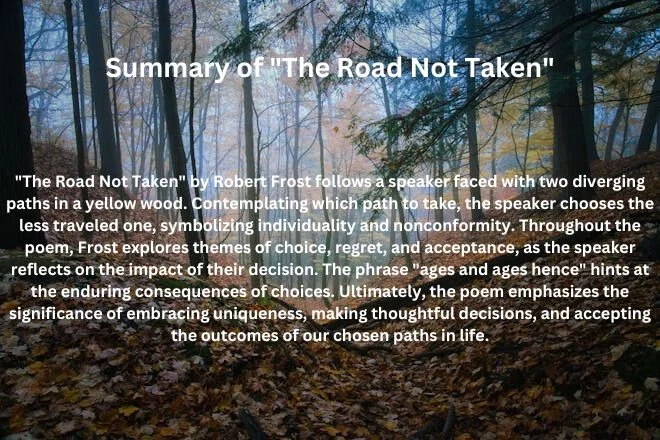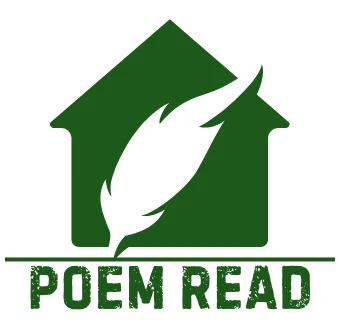
Robert Frost’s “The Road Not Taken” is a poem that has intrigued and challenged readers with its simple yet profound narrative. Written in 1915, this piece captures the essence of a moment of choice, where the speaker stands at a fork in the woods, deliberating on which path to take.
The poem’s beauty lies in its universal appeal, as it mirrors the countless decisions that shape our lives. Frost’s use of imagery, metaphor, and a contemplative tone invites readers to reflect on the paths they’ve chosen and the ones they’ve left unexplored.
In this article, we will explore the various literature-related aspects of this iconic poem. From understanding the subject and context to examining the theme, tone, form, and structure, we will delve deep into the layers of meaning within Frost’s work. So, let’s embark on this literary journey together and uncover the beauty and significance of “The Road Not Taken.”
The Road Not Taken
BY ROBERT FROST
Two roads diverged in a yellow wood,
And sorry I could not travel both
And be one traveler, long I stood
And looked down one as far as I could
To where it bent in the undergrowth;
Then took the other, as just as fair,
And having perhaps the better claim,
Because it was grassy and wanted wear;
Though as for that the passing there
Had worn them really about the same,
And both that morning equally lay
In leaves no step had trodden black.
Oh, I kept the first for another day!
Yet knowing how way leads on to way,
I doubted if I should ever come back.
I shall be telling this with a sigh
Somewhere ages and ages hence:
Two roads diverged in a wood, and I—
I took the one less traveled by,
And that has made all the difference.
Content
- About the Author: Robert Frost
- Subject of "The Road Not Taken"
- Context of "The Road Not Taken"
- Theme of "The Road Not Taken"
- Tone of "The Road Not Taken"
- Form and Structure of "The Road Not Taken"
- The persona, narration, and setting in "The Road Not Taken"
- Line-by-Line Analysis of "The Road Not Taken"
- Poetic and Literary Devices Used in "The Road Not Taken"
- Implications and Meanings in "The Road Not Taken"
- FAQ
- Interactive Summary of "The Road Not Taken"
About the Author: Robert Frost
Robert Frost, born on March 26, 1874, in San Francisco, California, is one of America’s most revered poets. His poetry is celebrated for its portrayal of New England’s rural landscapes, use of American colloquial speech, and realistic depiction of ordinary people in everyday situations. Frost’s work often examines complex social and philosophical themes, a reflection of his deep understanding of human nature and the environment.
Frost’s early years were marked by personal tragedy and a relentless pursuit of his poetic aspirations. Despite facing numerous challenges, including the death of his father and the struggle to find financial stability, Frost’s passion for poetry never waned. His dedication paid off when he became the only poet to receive four Pulitzer Prizes for poetry, cementing his legacy as a literary giant.
His poems, such as “The Road Not Taken” and “Stopping by Woods on a Snowy Evening,” continue to inspire and resonate with readers, reflecting the timeless and universal nature of his work. Frost passed away on January 29, 1963, in Boston, Massachusetts, but his poetry endures, a testament to the power of his words and the depth of his insight into the human experience.
Subject of “The Road Not Taken”
At the heart of “The Road Not Taken” lies the subject of choice and its everlasting imprint on our lives. Robert Frost presents us with a metaphorical crossroads—a moment that each of us faces countless times. The two paths in the yellow wood are more than just trails in a forest; they represent the decisions that define our existence. With each choice, a road is taken, and another is left behind, possibly forever.
The poem’s subject is not just about the act of choosing but also about the thoughts and emotions that accompany these pivotal moments. It’s about the allure of the unknown and the comfort of the familiar. Frost captures the essence of human nature—the desire to explore, the fear of missing out, and the inevitable reflection on what might have been.
This poem speaks to the adventurer in all of us—the part that yearns to break free from the well-trodden path and venture into the uncharted. Yet, it also acknowledges the reality that we cannot experience every possibility. In simple yet powerful language, Frost conveys a truth that resonates with everyone: the choices we make are significant, and they pave the path of our individual journeys.
Context of “The Road Not Taken”
The context of “The Road Not Taken” is deeply intertwined with Robert Frost’s personal experiences and the time in which it was written. Composed in 1915 and published in his collection “Mountain Interval” in 1916, the poem reflects the period’s social and philosophical introspection.
Frost’s friendship with British writer Edward Thomas is often cited as an influence on the poem. Their walks together in the English countryside, and Thomas’s indecisiveness about which path to take, sparked the poem’s creation. This personal anecdote gains a universal dimension as it mirrors the indecision we all face at various points in our lives.
Moreover, the poem’s publication during World War I adds a layer of meaning, considering Thomas’s subsequent enlistment and death in the war, which casts a shadow over the poem’s contemplation of choice and consequence.
Theme of “The Road Not Taken”

The theme of “The Road Not Taken” revolves around the complexities of decision-making, the consequences of choices, and the concept of individuality. Through the metaphor of two diverging paths in a yellow wood, the poem explores the pivotal moments in life when we must choose between different options, each leading to distinct outcomes.
One of the central themes is the idea of choice and its long-term impact. The speaker’s reflection on taking “the one less traveled by” highlights the significance of unconventional decisions and the potential for unique experiences and growth. This theme resonates with readers as it prompts introspection about their own choices and the paths they have taken.
Another key theme is the notion of consequences and hindsight. The speaker expresses a mix of regret and acceptance, recognizing that every choice closes off alternative possibilities. This theme invites readers to consider the ripple effects of decisions and the unpredictable nature of life’s journey.
Furthermore, “The Road Not Taken” touches on the theme of individuality and self-discovery. By choosing a less-traveled path, the speaker asserts their autonomy and willingness to carve out their destiny, even if it means diverging from the mainstream. This theme encourages readers to embrace their uniqueness and embrace opportunities for personal growth and exploration.
Tone of “The Road Not Taken”
The tone of “The Road Not Taken” by Robert Frost is thoughtful and nostalgic. The speaker reflects on past decisions with a mix of regret and acceptance, creating a sense of looking back on life experiences. This tone isn’t overly sad or joyful, but it has a deep emotional depth that makes it relatable.
From the start, the speaker feels sorry for not being able to take both paths, showing a sense of missed opportunities and the need to make choices. As the poem goes on, the tone becomes more contemplative as the speaker explains why they chose the less-traveled path.
There’s a touch of nostalgia in the speaker’s voice when they imagine telling this story in the distant future. It feels like they’re looking back with wisdom and a bit of longing, which adds depth to the poem. This nostalgic tone encourages readers to think about their own past choices and the roads they’ve taken in life.
Form and Structure of “The Road Not Taken”
The form and structure of “The Road Not Taken” play a significant role in conveying its themes and enhancing its poetic impact. Robert Frost employs a structured form, a consistent rhyme scheme, and deliberate use of punctuation to create a rhythmic and engaging poem.
Form
The poem consists of four stanzas, each containing five lines, known as quintains. This structured form provides a sense of balance and order to the narrative, allowing the reader to follow the speaker’s contemplative journey through decision-making.
Rhyme Scheme
The rhyme scheme follows an ABAAB pattern in each stanza. This means that the first, second, and fourth lines rhyme with each other, while the third and fifth lines rhyme separately.
For example, in the first stanza:
“Two roads diverged in a yellow wood, (A)
And sorry I could not travel both (B)
And be one traveler, long I stood (A)
And looked down one as far as I could (A)
To where it bent in the undergrowth; (B)”
The consistent rhyme scheme adds musicality to the poem and reinforces key points within each stanza.
Meter
The poem maintains a consistent meter, primarily iambic tetrameter. This means that each line typically consists of four iambs, with an unstressed syllable followed by a stressed syllable. For instance, in the first line, “Two roads diverged in a yellow wood,” the natural emphasis falls on the second syllable of “roads,” creating an iambic rhythm. The rhythmic pattern of the meter contributes to the poem’s flow and readability.
Punctuation
Frost’s use of punctuation is deliberate and serves to enhance the meaning and tone of the poem. Commas are strategically placed to create pauses and emphasize certain phrases, such as in the line “And be one traveler, long I stood,” where the comma indicates a pause for reflection.
Additionally, Frost employs semicolons and exclamation marks sparingly but effectively. For instance, the exclamation mark in the line “Oh, I kept the first for another day!” conveys the speaker’s sudden realization or emotional emphasis.
The persona, narration, and setting in “The Road Not Taken”
The persona, narration, and setting in “The Road Not Taken” contribute significantly to its emotive impact and relatability. Robert Frost’s persona in the poem is that of a reflective and introspective individual, contemplating a past decision that shaped their life’s journey. The speaker’s voice is characterized by a mix of regret, acceptance, and curiosity, making it relatable to readers who have experienced moments of indecision and choice.
The narration style is first-person, allowing readers to directly connect with the speaker’s thoughts and emotions. This intimate narrative approach invites readers into the speaker’s internal dialogue as they recount standing at a fork in the road, faced with two diverging paths. The use of “I” throughout the poem emphasizes the personal nature of the reflection, drawing readers into the speaker’s contemplative mindset.
The setting of the poem is crucial in creating imagery and mood. The mention of “a yellow wood” evokes a sense of nature and tranquility, setting the scene for the speaker’s moment of decision. The imagery of the woods, with its diverging paths and undergrowth, adds depth to the setting and enhances the metaphorical significance of the crossroads as a metaphor for life’s choices.
Line-by-Line Analysis of “The Road Not Taken”

First Stanza
Two roads diverged in a yellow wood,
And sorry I could not travel both
And be one traveler, long I stood
And looked down one as far as I could
To where it bent in the undergrowth;
The first stanza sets the stage for the poem’s exploration of choice, consequence, and the human condition. It uses simple language to convey complex emotions and themes, engaging the reader with its vivid imagery and relatable subject matter. Frost’s careful choice of words and structure in this stanza lays the foundation for the reflective journey that unfolds in the subsequent verses.
Line 1
This opening line paints a picture of a person standing at a crossroads where two paths split in a forest with yellow leaves. The use of “diverged” suggests the paths are separating, indicating a significant decision point. Additionally, the mention of “yellow wood” suggests autumn, a season of change and transition.
Moreover, the “yellow wood” sets a serene yet contemplative mood, as yellow is often associated with aging and the later stages of life. All these aspects together point to a time of transformation, mirroring the decision-making process and the passage of time.
Line 2
Here, the speaker expresses a sense of regret or sorrow at the impossibility of walking on both paths simultaneously. Here, Frost highlights the limitations of choice and the necessity of making a decision. Besides, this line suggests that making a choice results in forfeiting alternative options.
Furthermore, the speaker uses personification by attributing human emotions (“sorry”) to the act of not being able to travel both paths. This personification adds depth to the speaker’s contemplation and underscores the emotional weight of the decision.
Line 3
This line conveys the speaker’s hesitation and contemplation before making a choice. The phrase “long I stood” implies a prolonged period of indecision or thoughtful consideration. Additionally, the speaker utilizes both anaphora (repetition of “And”) and enjambment (continuing the sentence without punctuation) to create a flowing rhythm.
This emphasizes the speaker’s prolonged hesitation as well as the ongoing nature of decision-making. Moreover, the use of “one traveler” highlights the solitary nature of decision-making.
Line 4
The speaker visually inspects one of the paths, trying to see as far as possible to gauge where it leads. This action reflects the speaker’s desire for clarity and foresight before making a decision. This represents our desire to predict the consequences of our choices. However, the view is limited, symbolizing the uncertainty that accompanies decisions.
Line 5
The path disappears into the underbrush, indicating that the future cannot be fully known or seen. The undergrowth symbolizes the unknown and the challenges that lie ahead. This line concludes the stanza with a sense of mystery and the unknown, as the undergrowth obscures the path ahead.
Second Stanza
Then took the other, as just as fair,
And having perhaps the better claim,
Because it was grassy and wanted wear;
Though as for that the passing there
Had worn them really about the same,
The second stanza deepens the poem’s exploration of choice and consequence. Frost uses simple language to convey the complexity of decision-making and the human inclination to find reasons for our choices, even when they’re not clear-cut. The stanza captures the essence of introspection and the subtle doubts that accompany our decisions
Line 6
The speaker decides on the other path, which seems equally appealing (“just as fair”). This line suggests that both options in life can appear equally viable, making the choice difficult. Hence, it marks the moment of choice and introduces the theme of evaluating options based on initial impressions.
Line 7
Here, the speaker acknowledges that the second path may have seemed to offer better opportunities or advantages (“better claim”). This line reflects the subjective nature of decision-making and the perception that one option is more favorable. On the other hand, it reflects our tendency to justify our decisions, even when the differences are minor.
Line 8
In this line, the speaker provides a rationale for choosing the second path, noting that it was less worn (wanted wear”). Furthermore, the path is described as “grassy,” implying it’s less traveled and more inviting. Frost uses personification by giving the grassy path a desire for “wear,” which makes it seem inviting and attractive. This personification makes the natural elements in the poem feel alive and engaging, drawing the reader into the speaker’s contemplation.
Line 9
This line introduces a contrast or contradiction to the previous observation. Here, the speaker begins to doubt the initial observation, noting that the path has been traveled. This line contains juxtaposition, contrasting the initial perception of the grassy path with the reality of previous travelers having passed through.
This contrast adds depth to the speaker’s reflection on choice and appearance versus reality. Therefore, this line introduces uncertainty, a common feeling after making a decision.
Line 10
The speaker’s realization that both paths had been equally traveled challenges the initial perception of one path being less traversed. This revelation adds depth to the speaker’s assessment of the paths and the theme of choice and consequence.
Upon closer inspection, the speaker recognizes that different choices may lead to similar outcomes, highlighting the complexity of decision-making and the unpredictability of results. This ironic twist in perception enriches the thematic exploration of the poem, inviting readers to reconsider their assumptions about choices and their outcomes.
Third Stanza
And both that morning equally lay
In leaves no step had trodden black.
Oh, I kept the first for another day!
Yet knowing how way leads on to way,
I doubted if I should ever come back.
The third stanza of “The Road Not Taken” deals with the themes of choice, consequence, and the irreversible nature of decisions. Frost uses simple language to convey deep emotional and philosophical insights, engaging the reader in a reflection on the paths they choose in life.
In this stanza, the speaker reflects on the two diverging paths and their conditions. The speaker observes that both paths appear equally untrodden, yet they decide to take the second path described as “just as fair” and “grassy” but less traveled. The stanza reveals the speaker’s initial choice and hints at the uncertainty and contemplation that accompany decision-making.
Line 11
The speaker observes that both paths appeared equally untouched or untraveled that morning. This observation sets the stage for a deeper exploration of the consequences of choice and the passage of time.
Here, Frost uses personification by attributing the ability to “lay” equally to the paths, creating a sense of balance and equality between them. This personification adds depth to the speaker’s observation of the path’s condition.
Line 12
The imagery of “leaves no step had trodden black” symbolizes the absence of previous footprints, emphasizing the paths’ untouched nature and potential for exploration. This imagery conveys the freshness of the paths, symbolizing new opportunities.
The speaker describes the paths as covered with leaves that had not been darkened by footsteps, indicating their untouched condition. This reinforces the idea of both paths being equally viable options, as neither had been extensively walked upon recently.
Line 13
Here, the speaker expresses a desire to save the first path for a future opportunity, suggesting a reluctance to fully commit to one choice and an openness to revisiting decisions in the future. This reflects a common human tendency to postpone choices and seek reassurance about future possibilities.
Additionally, this line contains an exclamation (“Oh”) and serves as an interjection, expressing the speaker’s emotional attachment or hesitation toward the first path. The use of exclamation adds a tone of urgency or realization.
Line 14
This line introduces doubt as the speaker acknowledges that one choice often leads to another, making a return unlikely. The phrase “way leads on to way” suggests life’s complexity and interconnectedness. It reflects the speaker’s understanding of continuous choices in life.
The use of enjambment and alliteration with the repetition of “way” creates a rhythmic flow, emphasizing the speaker’s grasp of life’s continuous journey. The metaphorical phrase “way leads on to way” describes how one decision often leads to another, making it hard to retrace steps.
Line 15
The speaker expresses doubt about returning to the forsaken path, highlighting the irreversible nature of choices and the need to live with their consequences. This doubt reveals an internal struggle with the finality of their decision.
The period at the end of the line adds a sense of closure to the speaker’s uncertainty. It reflects hesitation about revisiting the first path, deepening the theme of missed opportunities and irreversible choices.
Final Stanza
I shall be telling this with a sigh
Somewhere ages and ages hence:
Two roads diverged in a wood, and I—
I took the one less traveled by,
And that has made all the difference.
The final stanza of the poem ends with the speaker thinking about the results of their chosen path. They expect to tell the story of their decision with a “sigh” in the future. This shows a mix of regret, acceptance, and introspection. The phrase “ages and ages hence” hints at the lasting impact of choices over time. The speaker confirms their decision to take the less traveled path, recognizing its importance in shaping their life. This is symbolized by the phrase “And that has made all the difference.”
Line 16
The speaker envisions a future moment when they’ll recall their choice with a “sigh,” hinting at feelings of regret or nostalgia. Yet, this “sigh” could also carry relief or contentment, leaving room for interpretation.
This anticipation of storytelling with a “sigh” holds irony, blending regret and acceptance. It also foreshadows the lasting impact of the decision, suggesting its significance. Using “sigh” adds emotional depth as it echoes the sound it represents—a classic example of onomatopoeia, enhancing the poem’s conclusion.
Line 17
This line extends the reflection into the distant future, emphasizing the significance of the decision. The repetition of “ages” emphasizes just how long-lasting the impact of the choice will be on the speaker’s life. Through hyperbole, “ages and ages” amplifies the far-off timeframe, highlighting the timeless essence of the poem.
Moreover, “hence” conveys a sense of distance and the ongoing passage of time. Ultimately, the phrase “ages and ages hence” strongly underscores the lasting resonance of the speaker’s story and the enduring consequences of their choices.
Line 18
The speaker reflects on the initial moment of choice, completing a full circle back to the poem’s beginning. By using a dash after “I,” there’s a pause that adds dramatic effect and highlights the speaker’s role in the decision. This repetition of “I” at the start of the next line, known as anaphora, emphasizes the personal experience of the speaker.
The dash, called a caesura, creates a significant pause, drawing attention to the decision-making moment. The phrase “two roads diverged” metaphorically symbolizes life’s choices, and the dash underscores the speaker’s individuality and the weight of their decision.
Line 19
The speaker boldly claims to have chosen the “less traveled” path, often seen as a celebration of uniqueness and nonconformity. However, the poem’s ambiguity suggests that this “less traveled” aspect might be more about perception than reality, adding complexity to the speaker’s assertion.
The path serves as a metaphor for life’s choices, symbolizing individuality and the direction one chooses in life. This phrase, “less traveled by,” uses both euphemism and metaphor to convey the speaker’s choice of an unconventional or less common path. By reaffirming their decision, the speaker showcases their independence and willingness to diverge from societal norms.
Line 20
The final line of “The Road Not Taken” by Robert Frost emphasizes how much the speaker’s choice has affected their life. The phrase “all the difference” is deliberately vague, letting readers think about how this decision changed the speaker’s journey. This open-endedness lets readers reflect on their own important moments and the impact of their choices.
By comparing the chosen path with the alternative, the line exaggerates to show how big of an impact the speaker’s decision had. In summary, the poem ends by showing how important choices are and how they shape our lives in meaningful ways.
Poetic and Literary Devices Used in “The Road Not Taken”
Metaphor
Robert Frost employs metaphorical language throughout “The Road Not Taken” to convey deeper meanings. For instance, the diverging paths in the woods symbolize life choices and the paths individuals take. The phrase “yellow wood” represents a transitional phase in life or a moment of decision. These metaphors enrich the poem’s thematic exploration of choices, individuality, and life’s journey.
Imagery
The poem is rich in visual imagery, painting vivid pictures in the reader’s mind. Lines like “Two roads diverged in a yellow wood” evoke a clear image of a forest with two distinct paths. Frost’s descriptions of the paths being “grassy and wanted wear” and “fair” create sensory experiences that enhance the reader’s engagement with the poem.
Alliteration
Frost uses alliteration, the repetition of consonant sounds, to add musicality and emphasis to certain phrases. For example, in the line “And having perhaps the better claim,” the repetition of the “h” sound in “having” and “perhaps” creates a rhythmic flow. This literary device helps draw attention to key ideas and enhances the poem’s overall sound and structure.
Symbolism
The use of symbols in “The Road Not Taken” adds layers of meaning to the poem. The two roads symbolize choices in life, with one representing the conventional path and the other symbolizing a unique or unconventional choice. The “sigh” in the final stanza symbolizes a mix of regret and acceptance. These symbols deepen the poem’s exploration of decision-making, individuality, and the consequences of choices.
Personification
Frost employs personification by attributing human qualities to non-human elements. For instance, the phrase “wanted wear” gives the impression that the grassy path desires to be walked upon, adding a sense of invitation and allure. This personification adds depth and emotion to the natural elements described in the poem.
Repetition
Repetition is used strategically in “The Road Not Taken” to emphasize key themes and ideas. The repetition of the word “ages” in the phrase “ages and ages hence” highlights the enduring impact of choices over time. This repetition reinforces the poem’s message about the lasting consequences of decisions.
Assonance
Assonance is the repetition of vowel sounds within words or phrases. In the poem, Frost employs assonance to create a musical and rhythmic effect. For example, in the line “I doubted if I should ever come back,” the repetition of the “ou” sound in “doubted,” “should,” and “come” creates a harmonious and flowing quality. This use of assonance enhances the poem’s oral appeal and contributes to its overall lyrical quality.
Consonance
Consonance, on the other hand, is the repetition of consonant sounds within words or at the end of words. Frost skillfully uses consonance to add emphasis and create a sense of unity in the poem. For instance, in the line “To where it bent in the undergrowth,” the repetition of the “t” sound in “bent” and “undergrowth” creates a subtle yet effective connection between the words. This consonance helps to reinforce the imagery of the bending path and adds a sense of continuity to the description.
Implications and Meanings in “The Road Not Taken”

“The Road Not Taken” by Robert Frost is a poem that has intrigued readers for over a century. At first glance, it seems to celebrate the idea of taking a unique path in life. However, upon closer examination, the poem reveals a complex web of implications and meanings that resonate with the human psyche.
Choice and Individuality
The poem’s most apparent implication is the significance of choice. The act of choosing one path over another symbolizes life’s decisions and their impact on our journey. It suggests that our choices define us, carving out our individual paths in the world.
Regret and Reflection
Frost also delves into the theme of regret. The speaker’s future reflection, “with a sigh,” implies a sense of loss or wonder about the path not taken. This speaks to the human condition of pondering ‘what if’ scenarios and the natural inclination to reflect on past decisions.
The Illusion of Difference
Interestingly, the poem questions whether the chosen path was genuinely less traveled. This ambiguity challenges the reader to consider if the choices we glorify as unique are indeed different or if it is merely our perception that grants them significance.
The Inevitability of Choice
The poem underscores that choice is inevitable and consequential. The speaker’s acknowledgment that “way leads on to way” suggests that one choice leads to another, creating a domino effect in our lives. It highlights the interconnectedness of our decisions and their long-term effects.
The Universality of Experience
Finally, the poem touches on the universal experience of standing at life’s crossroads. It connects with readers across generations, as everyone encounters moments of decision that shape their destiny.
In essence, “The Road Not Taken” is a contemplative piece that encourages readers to think deeply about the paths they choose and the life they craft as a result. It’s a poem that continues to inspire and provoke thought, proving its timeless appeal.
FAQ
What is the main theme of “The Road Not Taken”?
The main theme is the significance of the choices we make in life and how they define our journey. It explores the idea that even seemingly minor decisions can have a significant impact on our lives.
What is the main message of “The Road Not Taken”?
The main message of the poem is about the significance of individual choices and the impact they have on one’s life journey. It encourages readers to reflect on the paths they choose and the importance of embracing uniqueness.
Who is the speaker in the poem?
The speaker is an unnamed individual who reflects on a past decision to take a less-traveled path in the woods, which serves as a metaphor for life’s choices.
What does the “yellow wood” symbolize?
The “yellow wood” symbolizes a place of decision-making and change, potentially referring to the autumn of life or a period of transition.
What does the phrase “the road less traveled” mean?
The phrase “the road less traveled” symbolizes taking a path that is unconventional or less commonly chosen. It represents individuality, nonconformity, and the willingness to forge one’s own way despite societal expectations.
Is the speaker happy with their choice?
The poem leaves this ambiguous. The speaker predicts they will recount their choice “with a sigh,” which could indicate either contentment or regret.
Is “The Road Not Taken” a poem about regret?
While the poem explores themes of choice and contemplation, it is not solely about regret. It acknowledges the complexity of decision-making and emphasizes acceptance of the consequences of one’s choices.
What is the significance of the sigh mentioned in the poem?
The “sigh” mentioned in the poem represents a mix of regret, acceptance, and introspection. It signifies the speaker’s contemplation of paths not taken while also acknowledging the impact of the chosen path.
What is the significance of the title “The Road Not Taken”?
The title emphasizes the road that was not chosen, suggesting a contemplation of missed opportunities and lasting curiosity about the path not traveled.
What lesson can readers learn from “The Road Not Taken”?
Readers can learn the importance of embracing individuality, making thoughtful choices, accepting consequences, and finding peace with the paths they choose in life.
Interactive Summary of “The Road Not Taken”
“The Road Not Taken” by Robert Frost is a reflective poem that explores themes of choice, individuality, and the consequences of decisions. The speaker describes coming across two diverging paths in a wood and facing the dilemma of which one to take. After much contemplation, the speaker chooses the less traveled path, symbolizing a desire for uniqueness and nonconformity.
Throughout the poem, Frost uses metaphors, imagery, and symbolism to convey deeper meanings about life’s choices and their lasting impact. The phrase “ages and ages hence” suggests the enduring significance of decisions over time. The poem ends with the speaker acknowledging the difference their choice has made in their lives, emphasizing the importance of individual choices and the paths we take.
Overall, “The Road Not Taken” encourages readers to reflect on their own decisions, celebrate their uniqueness, and accept the consequences of their choices. It is a timeless exploration of the complexities of decision-making and the value of embracing individuality.
So, as you reflect on the words of Robert Frost, remember the significance of the roads we choose to travel and the difference they can make in our lives.
If you’re interested in exploring more of Robert Frost’s poetry, don’t miss our analysis of “Nothing Gold Can Stay,” another masterpiece that explores themes of impermanence and the fleeting nature of beauty.
RELATED POSTS
View all



